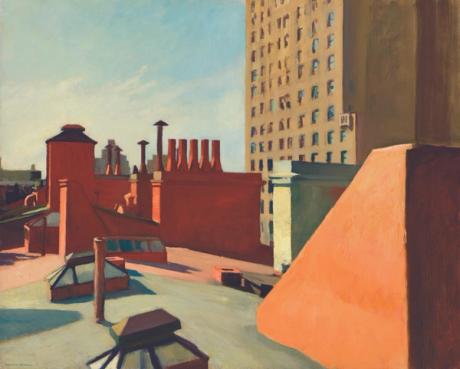[ad_1]

For all that’s been said about the American painter Edward Hopper (1882-1967), the artist still remains something of an enigma. Perhaps it is the strangeness of his paintings, which often focus on quiet, ephemeral moments where little is happening and yet some kind of revelation seems imminent. Perhaps it is the inscrutability of the man himself, whose few statements revealed little of his inner life. Or perhaps it is the legend that still looms large around Hopper as an emphatically American artist—that of the self-made, lonesome hero; an outlier in his own day and age.This sense of Hopper’s idiosyncrasy is largely kept intact by Edward Hopper’s New York, a vast and varied exhibition that brings together a wealth of rarely seen works with many of his most revered urban paintings. Though there are some notable omissions—most obviously the 1942 painting Nighthawks, unavailable for loan from the Art Institute of Chicago—the show features no shortage of prominent canvases, drawing from the Whitney’s own collection and a number of major loans. These cover the artist’s lifelong creative relationship with the city in which he lived, taking us from restaurants, offices and theatres to bridges, tunnels and rooftops.Seeing these works grouped together, it becomes ever more apparent that Hopper’s New York is almost always one that other artists of his age ignored: where the Ash Can painters sought out the crowds and the bustle of everyday life, Hopper searched for the empty corners, for quiet lives taking place behind windows, for moments of reverie. Where the Modernists looked up at the skyscrapers, Hopper focused on historic, unfashionable buildings. In short, New York became a muse and mirror through which Hopper could project his own personality; as he told one interviewer in 1963, his great quest in art was self-discovery. His images of New York were never intended to provide any kind of social document or commentary, despite inadvertently charting important phases of the city’s history and ongoing reinvention.An unrivalled collectionThe show digs deep into the Whitney’s unrivalled collection of more than 3,000 Hopper works (left to the museum by his widow Josephine after she died). Spanning the artist’s full career, more than 200 works are spread across a sprawling space that encourages visitors to choose their own path through thematic groupings, including “The Horizontal City”, “Reality and Fantasy” and “The Window”. As the curator Kim Conaty says, the design is intended to “emulate that exploratory experience of moving around the city on your own” and to “underscore just how much Hopper returns to the same themes and motifs”.The design is largely successful, though the exhibition is at its strongest when it is most focused. In particular, “The City in Print” section—bringing together Hopper’s early illustrations, advertisements and magazine covers—will be a revelation to the casual viewer, showing the breadth of the artist’s talent and output, as well as the ways in which several of his figurative illustrations seem to foreshadow the narrative tensions in his future oils. While this insight is not new (Gail Levin’s 1979 publication on Hopper’s illustrations first drew attention to these parallels), the exhibition teases out this relationship through insightful curatorial choices, choosing, for example, to display Hopper’s 1940 tour de force Office at Night beside a number of his early illustrations of office settings.The “Washington Square” display is another highlight, bringing Hopper’s tender portraits of his wife Jo together with a stunning display of watercolours and drawings. Occasionally, however, groupings of the artist’s works perplex. Hopper’s poignant final oil painting Two Comedians (1966)—portraying him and his wife dressed as commedia dell’arte performers taking their final bow—is displayed next to the largely unrelated 1932 painting Room in New York, with no wall text to tell us of the former work’s significance.Nevertheless, the diverse selection of works encourages us to do away with clichés and consider that Hopper’s vision of the city was as varied and complex as the man himself. What really stands out on seeing his urban paintings in the flesh is their surprisingly vibrant colouration, challenging the common idea that Hopper’s city pictures are dour or melancholy. Room in Brooklyn (1932) might at first suggest the alienation of its solitary protagonist, yet the warmth of its palette and the figure’s placement in a rectangle of golden light evokes something richer than loneliness—a trope Hopper himself felt was overdone.Edward Hopper’s New York is the first Whitney exhibition to capitalise on the 2017 donation of the Sanborn Hopper Archive, which includes a trove of hitherto inaccessible or unseen artworks and ephemera from the artist’s lifetime amassed by Reverend Arthayer Sanborn—a former minister and caretaker of Hopper’s childhood home in Nyack, where the artist’s sister lived until her death in 1965. This donation, which was recently the focus of a New York Times investigation into Sanborn’s acquisition of the collection, forms the curatorial backbone of Edward Hopper’s New York. Throughout the exhibition, items from the archive take centre-stage, including never-before-seen notebooks, letters and photographs offering rare access to the artist’s personal life and effects.Yet for all the detail these various items inject, one is left with the sense that Hopper remains curiously detached from the richer historical fabric of his age. He is scarcely related here to other New York cultural circles, for example; the influence of his teachers and compatriots at the New York School of Art is not mentioned in the section on Hopper’s “first impressions” of the city, despite their important impact on this formative phase of his development, and his relationships with artists, critics, curators and writers in New York are not discussed.• Edward Hopper’s New York, Whitney Museum of American Art Until 5 March 2023What other critics said about the exhibitionsIn her review for The Guardian, Veronica Esposito praises the show for helping audiences to see Hopper anew. She concludes that the exhibition “will give tourists and longtime New Yorkers much reason to refresh their eyes and rediscover a city that they thought they knew”. However, she perhaps overstates the extent to which the show “eschews many of the artist’s most famous paintings”, since many of his most iconic urban works are featured here.In a rave review for The New Yorker, Hilton Als describes the exhibition as “a terrific show based on a great idea, and it’s weird that no one thought to approach his work in this way before”, though it should be noted that Avis Berman’s 2005 book, also titled Edward Hopper’s New York, tackled the same subject, and other Hopper retrospectives have previously explored his relationship with New York through dedicated displays and catalogue essays.
[ad_2]


























